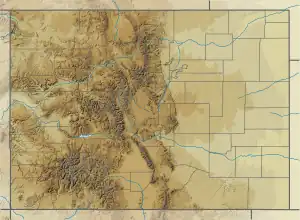Shoshoni Peak
Shoshoni Peak is a 12,967-foot (3,952 m) mountain summit on the boundary shared by Boulder County and Grand County, in Colorado, United States.[4]
| Shoshoni Peak | |
|---|---|
 East aspect, right of center, from Isabelle Lake (Navajo Peak and Apache Peak to left) | |
| Highest point | |
| Elevation | 12,967 ft (3,952 m)[1][2] |
| Prominence | 328 ft (100 m)[3] |
| Parent peak | Apache Peak (13,441 ft)[3] |
| Isolation | 0.86 mi (1.38 km)[3] |
| Coordinates | 40°04′01″N 105°38′20″W[4] |
| Naming | |
| Etymology | Shoshoni |
| Geography | |
 Shoshoni Peak Location in Colorado  Shoshoni Peak Shoshoni Peak (the United States) | |
| Country | United States |
| State | Colorado |
| County | Boulder / Grand |
| Protected area | Indian Peaks Wilderness |
| Parent range | Rocky Mountains Front Range[5] |
| Topo map | USGS Monarch Lake |
| Geology | |
| Age of rock | Mesoproterozoic[6] |
| Type of rock | Granite[6] |
| Climbing | |
| Easiest route | Hiking class 2[3] via Pawnee Pass[7] |
Description
Shoshoni Peak is set on the Continental Divide in the Front Range which is a subrange of the Rocky Mountains.[5] The mountain is located 20 miles (32 km) west of Boulder in the Indian Peaks Wilderness, on land managed by Arapaho National Forest and Roosevelt National Forest. It is the eighth-highest summit in the wilderness and 17th-highest in Boulder County.[3] Precipitation runoff from the mountain's slopes drains chiefly into the headwaters of South St. Vrain Creek, except for the northwest slope which drains to Monarch Lake via Cascade Creek. Topographic relief is significant as the summit rises 1,600 feet (488 m) above South St. Vrain Creek in less than one-half mile. An ascent of the peak involves hiking 12.5 miles (20.1 km) (round trip) with 3,400 feet (1,036 m) of elevation gain. The mountain's toponym was officially adopted in 1966 by the United States Board on Geographic Names.[8]

Climate
According to the Köppen climate classification system, the mountain is located in an alpine subarctic climate zone with cold, snowy winters, and cool to warm summers.[9] Due to its altitude, it receives precipitation all year, as snow in winter and as thunderstorms in summer, with a dry period in late spring. This climate supports the Isabelle Glacier on the southwest slope.
Climbing
Established climbing routes on Shoshoni Peak:[2]
- North Couloir – class class 2
- North slope – class 2
- Southwest Couloirs – class 3–5.2
See also
References
- Robert M. Ormes (2000), Guide to the Colorado Mountains, Colorado Mountain Club Press, ISBN 9780967146607, p. 60.
- Gerry Roach (1998), Colorado's Indian Peaks, Fulcrum Publishing, ISBN 9781555914042, p. 47.
- "Shoshoni Peak - 12,979' CO". listsofjohn.com. Retrieved April 27, 2023.
- "Shoshoni Peak". Geographic Names Information System. United States Geological Survey, United States Department of the Interior. Retrieved April 27, 2023.
- "Shoshoni Peak, Colorado". Peakbagger.com. Retrieved April 27, 2023.
- Geologic map of the Estes Park 30' x 60' quadrangle, north-central Colorado, W.A. Braddock, U.S. Geological Survey, 1984.
- Scott Warren (2002), Exploring Colorado's Wild Areas, Mountaineers Books, ISBN 9780898867848, p. 39.
- Decisions of the United States Geographic Board No. 6602, (1966), US Government Printing Office, p. 9.
- Peel, M. C.; Finlayson, B. L.; McMahon, T. A. (2007). "Updated world map of the Köppen−Geiger climate classification". Hydrol. Earth Syst. Sci. 11. ISSN 1027-5606.
External links
- Shoshoni Peak: weather forecast
- Shoshoni Peak rock climbing: Mountainproject.com